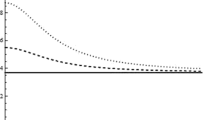Abstract
In the present paper, we consider single traveling waves (STW) generated by the oscillatory instability of Marangoni convection in the thin non-isothermal liquid layer with deformable free surface. The layer is covered by insoluble surfactant that plays an active role in the pattern selection together with inhomogeneity of temperature along the interface and surface deformability. Using the weakly nonlinear analysis we derived the modified complex Ginzburg–Landau equation describing the large-scale distortions of STWs near the bifurcation point. Linear stability analysis reveals existence of two modulational modes: one is for the amplitude and another one for the phase (Benjamin–Feir). Numerically, we found that STWs are stable with respect to longitudinal modulations in the case without surfactant. In the presence of the insoluble surfactant both modulational modes are found. The stability maps for different values of the surfactant concentration are plotted.



Similar content being viewed by others
Data availability statement
Data sets generated during the current study are available from the corresponding author on reasonable request.
References
J.P. Gollub, J.S. Langer, Pattern formation in nonequilibrium physics. Rev. Mod. Phys. 71, S396–S403 (1999). https://doi.org/10.1103/RevModPhys.71.S396
L. Pismen, Patterns and Interfaces in Dissipative Dynamics (Springer, Berlin, 2006)
M. Cross, H. Greenside, Pattern Formation and Dynamics in Nonequilibrium Systems (Cambridge University Press, Cambridge, 2009)
Ph. Ball, Patterns in Nature: Why the Natural World looks Way It Does (The University of Chicago Press, Chicago, 2016)
M. Maillard, L. Motte, A.T. Ngo, M.P. Pileni, Rings and hexagons of nanocrystals: a Marangoni effect. J. Phys. Chem. B 104, 11871–11877 (2000). https://doi.org/10.1021/jp002605n
K. Eckert, M. Acker, R. Tadmouri, V. Pimienta, Chemo-Marangoni convection driven by an interfacial reaction: pattern formation and kinetics. Chaos 22, 037112 (2012). https://doi.org/10.1063/1.4742844
H. Uchiyama, T. Matsui, H. Kozuka, Spontaneous pattern formation induced by Bénard–Marangoni convection for sol-gel-derived titania dip-coating films: effect of co-solvents with a high surface tension and low volatility. Langmuir 31, 12497–504 (2015). https://doi.org/10.1021/acs.langmuir.5b02929
S. Shklyaev, A. Nepomnyashchy, Longwave Instabilities and Patterns in Fluids (Birkhaüser, New York, 2017)
M.C. Cross, P.C. Hohenberg, Pattern formation outside of equilibrium. Red. Mod. Phys. 65, 851–1112 (1993). https://doi.org/10.1103/RevModPhys.65.851
S. Shklyaev, A.A. Alabuzhev, M. Khenner, Long-wave Marangoni convection in a thin film heated from below. Phys. Rev. E 85, 016328 (2012). https://doi.org/10.1103/PhysRevE.85.016328
O. Janiaud, A. Pumir, D. Bensimon, V. Croquette, H. Richter, L. Kramer, The Eckhaus instability for traveling waves. Physica D 55, 269–286 (1992). https://doi.org/10.1016/0167-2789(92)90060-Z
G. Dangelmayr, I. Oprea, Modulational stability of traveling waves in 2D anisotropic systems. J. Nonlinear Sci. 18, 1–56 (2008). https://doi.org/10.1007/s00332-007-9009-3
A.B. Mikishev, A.A. Nepomnyashchy, Patterns and their large-scale distortions in Marangoni convection with insoluble surfactant. Fluids 6, 282 (2021). https://doi.org/10.3390/fluids6080282
A.B. Mikishev, A.A. Nepomnyashchy, Marangoni patterns in a non-isothermal liquid with deformable interface covered by insoluble surfactant. Colloids Interfaces 6, 53 (2022). https://doi.org/10.3390/colloids6040053
A.C. Newell, J.A. Whitehead, Finite bandwidth, finite amplitude convection. J. Fluid Mech. 38, 279–303 (1969). https://doi.org/10.1017/S0022112069000176
L.A. Segel, Distant side-walls cause slow amplitude modulation of cellular convection. J. Fluid Mech. 38, 203–224 (1969). https://doi.org/10.1017/S0022112069000127
A. Samoilova, A.A. Nepomnyashchy, Longitudinal modulation of Marangoni wave patterns in thin heated from below: instabilities and control. Front. Appl. Math Stat. 7, 697332 (2021). https://doi.org/10.3389/fams.2021.697332
A.B. Mikishev, A.A. Nepomnyashchy, Weakly nonlinear analysis of long-wave Marangoni convection in a liquid layer covered by insoluble surfactant. Phys. Rev. Fluids 4, 094002 (2019). https://doi.org/10.1103/PhysRevFluids.4.094002
A.B. Mikishev, A.A. Nepomnyashchy, Amplitude equations for large-scale Marangoni convection in a liquid layer with insoluble surfactant on deformable free surface. Microgravity Sci. Technol. 23(Sup.1), S59–S63 (2011). https://doi.org/10.1007/s12217-011-9271-8
C.D. Eggleton, Y.P. Pawar, K.J. Stebe, Insoluble surfactants on a drop in an extensional flow: a generalization of the stagnated surface limit to deforming interfaces. J. Fluid Mech. 385, 79–99 (1999). https://doi.org/10.1017/S0022112098004054
T. Yamada, Y. Kuramoto, A reduced model showing chemical turbulence. Prog. Theor. Phys. 56, 681–683 (1976). https://doi.org/10.1143/PTP.56.681
Acknowledgements
A.N. acknowledges financial support from the Israel Science Foundation (Grant N. 843/18).
Author information
Authors and Affiliations
Corresponding author
Appendix A
Appendix A
Rights and permissions
About this article
Cite this article
Mikishev, A.B., Nepomnyashchy, A.A. Large-scale longitudinal distortions of Marangoni wave patterns in the non-isothermal liquid layer covered by surfactant. Eur. Phys. J. Spec. Top. (2024). https://doi.org/10.1140/epjs/s11734-024-01118-1
Received:
Accepted:
Published:
DOI: https://doi.org/10.1140/epjs/s11734-024-01118-1



